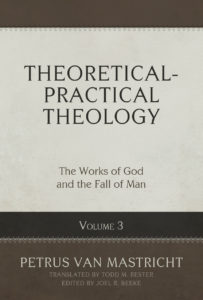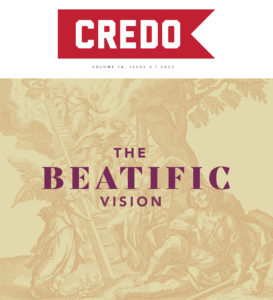There are several ways a baseball player can carve out a successful career for himself. He could try being the best player at one position or the best at one aspect of the game, like hitting. Often, the five best hitters of any given decade are destined for Cooperstown. There is, though, a less glamorous way to stay in the league. He could also try being really good at numerous positions and many facets of the game. The ability to play multiple positions, hit, and run the bases is an incredible asset to a team, and a player can find himself in a long, successful career by being a jack-of-all-trades.
For those who find themselves at the intersection of the sports fan/Reformed theology Venn Diagram, the comparison between Petrus van Mastricht’s T heoretical-Practical Theology and an all-around baseball player is (surprisingly) apt. Mastricht’s magnum opus, first written in Latin and translated into his native Dutch, is finally receiving an English translation, planned at over four thousand pages and seven volumes. The latest publication in this series, Volume III, covers two books: Book 3, The Works of God, and Book 4, The Fall of Man, and showcases how Mastricht was a theological jack-of-all-trades. He combines theological precision with doxological reflection – polemical concern with exegetical care in a way unique among the Reformed Scholastics. He is like the ballplayer who is really good at fielding, hitting, and baserunning.
heoretical-Practical Theology and an all-around baseball player is (surprisingly) apt. Mastricht’s magnum opus, first written in Latin and translated into his native Dutch, is finally receiving an English translation, planned at over four thousand pages and seven volumes. The latest publication in this series, Volume III, covers two books: Book 3, The Works of God, and Book 4, The Fall of Man, and showcases how Mastricht was a theological jack-of-all-trades. He combines theological precision with doxological reflection – polemical concern with exegetical care in a way unique among the Reformed Scholastics. He is like the ballplayer who is really good at fielding, hitting, and baserunning.
Biography and Summary
Petrus van Mastricht (1630-1706) was a Dutch pastor and theologian. He received his initial theological training from Johannes Hoornbeeck (1617-1666) and Gisbertus Voetius (1589-1676) at Utrecht University. While pastoring, Mastricht completed his master of arts and doctor of theology degrees at the University of Duisberg in 1669, subsequently accepting the position of professor of Hebrew and theology at the university in 1670. In 1677, Mastricht succeeded Voetius as professor of Hebrew and theology at Utrecht University, a position he held until his death in 1706.Mastricht is like the ballplayer who is really good at fielding, hitting, and baserunning. Click To Tweet
A typical chapter in Theoretical-Practical Theology follows a scholastic organization. After a brief introduction to the subject, Mastricht begins his “Exegetical Part,” where he carefully examines Scripture’s teaching on the subject. In these sections, Mastricht’s knowledge of the original languages and canonical connectedness of the text is on full display. Then, he moves to the “Dogmatic Part.” Here, Mastricht considers various theological discussions surrounding the subject. Next, Mastricht turns to the “Elenctic Part,” or his “polemic” section. This section contains specific polemical questions that Mastricht considers contra his contemporary opponents. For example, in his chapter on Creation in General, he considers the question, “Could a creature be an instrument of creation,” in which he argues against both Jews and Socinians that Christ could not have been a mere creature if he is attributed as Creator. Each chapter concludes with a “Practical Part,” where he provides applications for the doctrine under consideration. This section often reads like the conclusion of a sermon, calling the reader to respond in light of the discussed subject.
Volume 3 of Theoretical-Practical Theology covers the works of God and the fall of man. The volume begins with Book 3 and considers God’s actions and decrees before moving on to predestination, election, and reprobation. Then, Mastricht considers creation, the contents of the six days of creation, God’s ongoing relationship with creation, the creation of angelic beings, and the creation of man in God’s image. Book 4 then examines man’s apostasy. It begins by considering how man violated the covenant of nature (or the covenant of works). The volume concludes with Mastricht’s explanation of the doctrine of sin – including original sin, the nature of sin, and the punishment for sin.
Evaluation
Jonathan Edwards’ provocative assessment of Theoretical-Practical Theology adorns the volume’s back cover. While noting Francis Turretin’s (1623-1687) prowess at polemics, Edwards commends Mastricht as the overall superior work. Edwards concludes that Mastricht is better than any other book in the world except the Bible! While provocative, Edwards’ opinion is well-received because Theoretical-Practical Theology is truly a tour de force in systematic theology, and readers are sure to gain many benefits from reading it.Jonathan Edwards concludes that Mastricht is better than any other book in the world except the Bible! Click To Tweet
First, readers are confronted with Mastricht’s skill in all phases of his work. Ryan McGraw has noted in an evaluation of Theoretical-Practical Theology Volume I that while Turretin bests Mastricht in precision and Brakel bests him in depth of devotion, Mastricht is no slouch in these areas. Further, Mastricht’s exegetical prowess and positive treatments of theology outstrip both other authors. Readers will find McGraw’s assessment accurate in this volume as well. Mastricht’s division of every chapter into a four-fold division of exegesis, dogmatics, polemics, and application creates an unbelievably well-rounded, comprehensive volume.
Mastricht’s work is also commendable because it dispels the notion that anyone employing the scholastic methodology is merely concerned with the exact number of the heavenly host who can dance on the head of a pin. Theoretical-Practical Theology is a work of Reformed Scholasticism, a term that invites a host of prejudices and misunderstandings. For some, the term “scholasticism” might invoke the image of a cerebral and dour seventeenth-century theologian who gutted the faith of Calvin and replaced it with the Aristotelian philosophy of medieval Catholicism. Such an image is unfortunate because it does not represent the scholastic method or describe the Reformed Scholastics of the post-Reformation. Scholasticism is, first and foremost, a methodology, not a system of beliefs. It is a mode of theological inquiry that seeks the exegesis of Scripture, an examination of how a doctrine has been historically defined throughout church history, and how doctrine is expounded in contemporary debate.Mastricht’s work is commendable because it dispels the notion that anyone employing the scholastic methodology is merely concerned with the exact number of the heavenly host who can dance on the head of a pin. Click To Tweet
Anyone who reads Mastricht will realize that this methodology does not exclude doxological passion. He is not merely concerned with philosophical and theological musings but engages in deep exegetical work and tender pastoral application throughout the volume. Take, for example, Mastricht’s chapter on original sin. In his Exegetical Part, Mastricht exegetes Romans 5:12. He observes the grammar of the verse, taking time to note how individual words like θάνατος (death) and ἁμαρτία (sin), as well as phrases like καὶ οὕτως εἰς πάντας ἀνθρώπους ὁ θάνατος διῆλθεν (and thus death passed to all men) function in the verse. After providing twenty-eight pages worth of dogmatic and elenctic reflection on the doctrine and Rom 5:12, he turns to application, where he urges the reader, in light of the doctrine of original sin, to follow the example of David and Paul and humble ourselves before God (p. 478), marvel at the grace of God (p. 480), and even encourages parents to evaluate their raising of children in light of children’s natural corruption (p. 482). Precise exegesis and relevant application are not highlights of Mastricht’s work on this specific doctrine; they are a feature of his entire work. Readers will often find themselves looking at verses in a new light and feel their souls stirred by Mastricht’s waxing poetic on applying every doctrine to the Christian life.
Finally, in the Preface, Joel Beeke and Todd Rester provide several highlights of Mastricht’s teaching in the volume: His mediating lapsarian position, his rejection of Copernicanism, his defense of the reality of demons and magic, and his doctrine of the third heaven (p. xxvii). His lapsarianism, in particular, is a fruitful investigation. Mastricht saw himself between “rigid supralapsarianism” and “rigid infralapsarianism” (p. 34). Mastrict’s unique contribution to the discussion is his distinguishing between predestination on the one hand and election and reprobation on the other. Like an infralapsarian, Mastricht places predestination logically before the fall, but it is a predestining of an indefinite group. Mastricht's work dispels the notion that the scholastic methodology freezes any of its implementors in a block of ice. Click To TweetThe election and reprobation of certain fallen individuals occur after the fall. Beeke and Rester note that it is debatable whether separating predestination and election/reprobation comports with Romans 9:21-29 (p. xxxii). Later Dutch Reformed theologians, like Geerhardus Vos, would critique Mastricht on precisely this point, levying the claim that Mastricht impersonalizes predestination (Vos, Reformed Dogmatics, 1:148-55). Inadequacies abound in both positions, and Mastricht’s view is not free from its own. Still, his attempt to chart a via medina is interesting, and readers curious about this in-house Reformed discussion are sure to benefit from Mastricht’s analysis.
Conclusion
Like the jack-of-all-trades, Mastricht is able to discuss exegesis, theology, polemics, and application throughout Theoretical-Practical Theology to a degree not often seen. His work dispels the notion that the scholastic methodology freezes any of its implementors in a block of ice. Mastricht demonstrates that it is possible to synthesize precision and practicality. This work will serve both the pastor and the academic for years to come.


